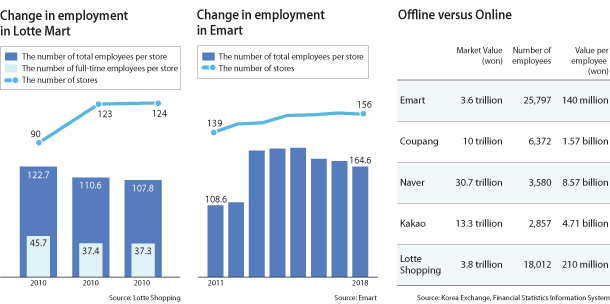Retail gigs drying up as automation spreads

The JoongAng Ilbo clocked four human cashiers versus 10 self-checkout counters with two employees backing up for 6 minutes at Lotte Mart in Seocho District, southern Seoul last November. The former group checked out 17 consumers, and the latter group checked out 12 consumers. For now, human cashiers are faster.
JoongAng Ilbo reporters also visited the 7-Eleven Signature store at Cheonggye Plaza, central Seoul. There, artificial intelligence (AI) and human cashiers were working together. AI cashier VENY, developed in 2017, is now found in 17 different 7-Eleven convenience stores nationwide. VENY senses and communicates with customers, assisting them as they check out. VENY costs roughly the same as the starting annual salary for college graduates. A low-end version of the VENY system is also available for one-tenth of the cost.
“If there is only one employee at the convenience store, he is caught up in the counter. Now, VENY can take the counter and the employee can do other duties,” a 7-Eleven employee said.
Lotte Mart retail stores employed a total workforce of 11,045 full-time and part-time employees as of December 2010, according to a business report from Lotte Shopping - approximately 122.7 employees per store. Eight years later, that total number had grown to 13,368, according to a December 2018 business report, but more widespread automation had caused a per-store drop of nearly 20 percent, to an average of 107.8 employees at each location.
At Emart, the country’s No. 1 discount store, a similar employment picture has taken shape in recent years.
At the time of its separation from Shinsegae Group in 2011, the retail giant was employing an average of 108 people per store. Employment climbed to 192.8 per store in 2015, before falling to 173.6 in 2017 and 164.6 in 2018.
However, the number of contract workers on Emart’s payrolls significantly increased during this period, from 16 (out of 15,000) in 2011 to a total of 414 by 2018.
Brick-and-mortar retail merchants are said to serve as “job gardens” in society, because operating a store requires a lot of work. Emart Group, with a market capitalization of 3.5 trillion won ($3 billion), employs 25,797 people. By contrast, Naver, which raises its sales by e-commerce alone, has a market cap of more than 30 trillion won but employs only 3,580 workers. E-commerce giant Coupang boasts a workforce of just 6,372 people.
With offline retail’s stagnant growth and weak domestic demand, options for those companies’ employees are increasingly limited because of automatic devices. Fewer shops are hiring people, and even these shops are trying to cut labor costs. The newly built distribution centers are structured in a way to require a minimal amount of workers. Most of the simple labor of sorting and collecting orders from new distribution centers for Emart and Coupang are now automated. Future automation is also expected to phase out the need for deliverymen.
“The industry that first loses jobs when introducing new technology is the retail industry,” said Kim Si-wuel, a consumer science professor at Konkuk University. “This is because the retail industry provides a lot of relatively low-value-added jobs.”
Anxiety within the existing workforce is tremendous. Shin Sang-hee worked as a cashier for seven years at an Emart in Jinjeop County in Namyangju, Gyeonggi. But last August, she was appointed to the processing service team and is now responsible for moving refrigerated and frozen goods from the freezers to the display shelves. Shin said three fellow cashiers were also sent to different departments once the retailer began installing self-checkout systems.
Emart has expanded its self-checkout machines to 95 stores of its 142 stores nationwide.
“Emart’s intention to introduce the unmanned cashier is not taking their current employees into consideration,” said Kim Ju-hong, the chairman of Emart’s trade union.
And from 2012 to 2018, convenience store employment levels dropped from an average of 6.6 employees per store to 5.0. Last year, when the increase in the minimum wage was in full swing, the number went down even further.
“The retail industry is facing a structural downturn due to large-scale store regulation and competition with e-commerce,” said Kang Seok-gu, chief of the industrial policy team at the Korea Chamber of Commerce and Industry. “This results in a decrease in the number of employees in the distribution industry.”
As jobs continue to disappear from Korea’s retail industry, related labor policies are getting a closer look.
“Unlike the manufacturing industry, the working hours often vary in the distribution industry, depending on the economic flow and sales,” said Kim Dong-wook, social policy managing director at the Korea Enterprises Federation. “Rigid labor policy hinders job growth, especially in the distribution industry where labor costs significantly affect competitiveness.”
To discourage increases in automation, some experts believe the labor market needs to get more flexible.
“Labor-intensive industries, such as the distribution industry, need to adopt more elastic labor policies so that the companies can easily recruit more workers,” Sungkyunkwan University economics Professor Cho Joon-mo said.
Others say Korea lacks societal concern for the people who have been doing simple work to find new jobs.
“Partly-automated convenience store Amazon Go in Seattle only has eight workers, when there were once 60 workers,” Suh Yong-gu, business and economics professor at Sookmyung Women’s University said. He warned, “If we do not plan ahead in response to the job losses that future innovations may bring, there is going to be labor market chaos in Korea.”
BY SPECIAL REPORTING TEAM [kim.yeonah@joongang.co.kr]










with the Korea JoongAng Daily
To write comments, please log in to one of the accounts.
Standards Board Policy (0/250자)